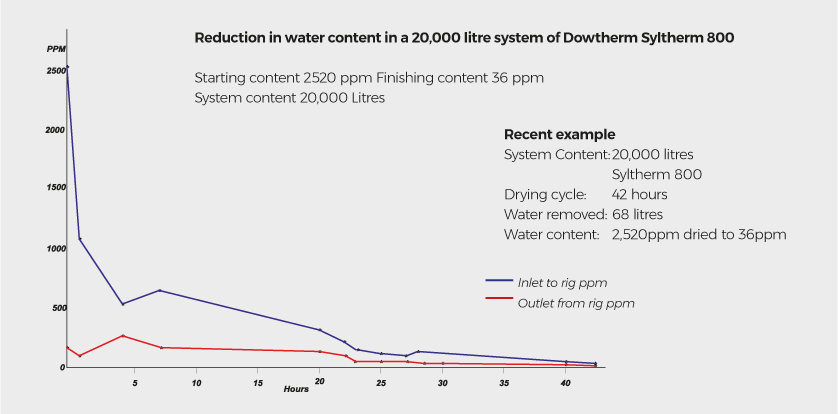Water Removal
Is the water in your Sub Zero Heat Transfer Fluid System costing you money?
Water causes extensive plant reliability problems and is a major cause of plant failure and production loss. Synthetic fluids are used as a heat transfer medium at temperatures down to –100°C and up to 400°C and water causes problems through the whole range. Sub zero systems are particularly susceptible to problems.
Introducing HT FluidDry
In order to reduce system water content, we have designed a range of mobile and fixed drying units based on ‘nitrogen stripping’ and ‘distillation’ principles. The HT FluidDry units can dry fluid down to below 10 parts per million while in continuous production at Sub Zero temperature or in stand alone batch processing.
The range of heat transfer fluid dryers are ideally suited for the following situations:
- At commissioning: To dry the system following system installation or modification
- During plant operation: To trim water levels without stopping production
- In emergency: Following accidental water ingress or heat exchange failure
- Stock fluids: Stand alone batch drying of ‘wet’ fluids
- Permanent installation: Dedicated to one or more process plants
- Mobile units: For operation on several plants as well as standby for emergencies
The Challenge
The water saturation point of heat transfer fluids varies with the fluid type and the operational temperature.
Free water, above the saturation point, will circulate as ice particles which will deposit themselves on heat exchanger surfaces, in chiller heat exchangers and in expansion tanks.
It should be noted that the surface temperature on heat exchangers will be far lower than the circulating fluid and that the refrigerant temperature should be taken into consideration. Allow at least 10°C lower than the fluid requirement.
As systems are closed loop, eliminating water is not easy. Cycling chillers and allowing individual reactor jackets to warm to release water still leaves the problem of removal as the water will simply deposit itself elsewhere in the system.
How does water get in?
New Systems
New systems, extensions and alterations not being sufficiently dried at commissioning.
New Fluid
Fluid suppliers do not necessarily guarantee a low moisture content on barrelled fluid.
Poor Housekeeping
• External filling points unprotected from the weather
• Barrels stood upright and not properly dried before use
• Barrels that are partially full being stored upright with loose caps
• The use of non dedicated filling pumps and hoses
Plant Failure
Water heat exchangers and/or reactor jackets failing.
Services
Saturated nitrogen used for blanketing. We have experienced systems where 30% water was found after a heat exchanger failure, with a complete plant closure. Similarly, we have seen systems where around 20ppm is causing maintenance headaches, particularly where Plate Heat Exchangers are used.
The Solution: HT FluidDry
Our HT FluidDry units, available for hire or purchase, are connected to the system as a side stream, taking a proportion of the flow through a heat exchanger to a temperature below the boiling point of the HT Fluid and above 100°C. The released vapours are then passed through a condenser to a second chamber where the condensate can be collected for safe disposal or further reconditioning.

If you would like more information on our HT FluidDry service, contact our expert team on +44(0)1298 815862
